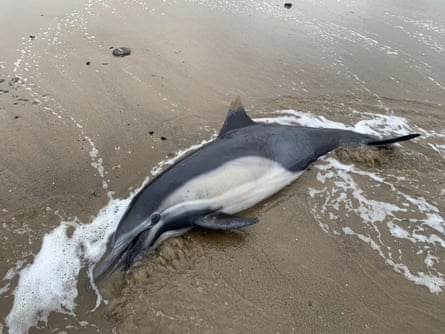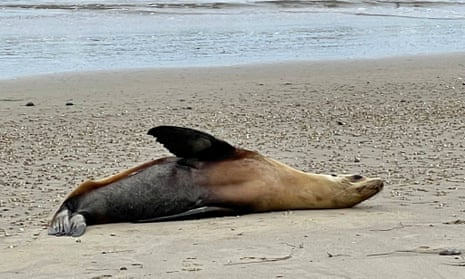On a recent morning on Leadbetter state beach in Santa Barbara, a California Sea Lion puppy, weighing about 30 or 40lbs, lay dead in the sand.
It’s the latest victim in what scientists and rescue organizations have described as an unprecedented event along the California coastline.
Since the beginning of June, dead sea lions and dolphins have been turning up all along the southern California coast – from the tiny Butterfly and Miramar beaches, down south to Santa Monica beaches in Los Angeles and even further to Laguna Beach in Orange county.
“The flood gates opened and it just gets worse every day. We’re getting 30 to 60 reports an hour and more than 300 reports a day,” said Ruth Dover, co-founder at Channel Islands Marine & Wildlife Institute (CIMWI), the marine mammal rescue organization in Santa Barbara.
The culprit is an algae named pseudo-nitzschia, which produces an amino acid that can act as a neurotoxin. A similar outbreak last year sickened dozens of sea lions and other marine life, but many think this year’s outbreak is even worse. Sam Dover, a co-founder of CIMWI and its director of veterinary medicine, notes that “in 35 years of doing this work, the current crisis is just unprecedented”.
Santa Barbara has been deemed the outbreak hotspot by the California Harmful Algae Risk Mapping (C-Harm) System, which tracks algae including the one that produces domoic acid. This epicenter has collided with pupping season which can bring upwards of 70,000 female sea lions to the Channel Islands in Santa Barbara to give birth in June.
Every harmful algae bloom (HAB) has its own features and this particular bloom seems to be coming from further offshore than usual. This means that in addition to an estimated more than 1,000 sick and dying sea lions, 110 dolphins have also been killed along the California coast. And these numbers don’t include those that may be dying at sea or out on the Channel Islands.

While the outbreaks are naturally occurring, scientists say their intensity appears to be increasing. “I’ve been studying domoic acid for 30 years and I have a feeling it’s getting worse based on the records we continue to break. Last year had the highest recorded levels of domoic acid in animal tissue we’ve ever seen,” said Clarissa Anderson, the executive director of the Southern California Coastal Ocean Observing System (SCCOOS) at the Scripps Institution of Oceanography. Levels in animal samples are still being tested for this year’s outbreak, but they are suspected to be the same amount of domoic acid, or worse.
What is driving the toxic blooms?
Like so many of the ocean’s one-celled organisms that produce rich nutrients and fatty acids for filter fish at the bottom of the food chain, pseudo-nitzschia can be harmless in normal conditions. But complex and dynamic ocean water changes can effectively “turn on” the production and proliferation of the algae and increased amounts of domoic acid, creating a harmful situation.
While some marine life is not affected at all by domoic acid, the neurotoxin can accumulate in animals lower on the food chain and affect those higher up who are feeding on the filter fish that count algae as their main food source. Sea lions, who are eating copious amounts of affected filter fish or other organisms at this time of year to make milk for a pup or sustain a pregnancy, seem to be especially susceptible to domoic acid as a neurotoxin.
Depending on where and when the algae hits the food web, it can also affect birds, dolphins and humans – if ingested from shellfish, which is why that industry is so closely regulated. It can also impact fisheries and native subsistence fishing by creating oxygen dead zones. Harmful algae blooms of every variety aren’t relegated just to California, but worldwide, and in freshwater as well.
The answer to what exactly is driving this outbreak, or why they are increasing in severity, is complex. Ocean water resembles a delicate broth comprised primarily of chloride, sodium, sulfate, magnesium, calcium and potassium, with a host of other ingredients that contribute to plant and marine life. Phosphorous and nitrogen, which are mostly responsible for driving plant and algae growth, accompany myriad other substances such as carbon, boron, strontium and bromide.
When this broth gets out of balance, algae can start to bloom in a harmful way. Factors contributing to an imbalance can include massive ocean-wide shifts like El Niño or underwater volcanoes, natural ocean cycles, lack of iron or other nutrients algae need, human wastewater, which can have high levels of urea even after being treated, and agricultural runoff, which can include pesticides, nitrogen-rich fertilizer and animal waste. Cold water upwelling is another factor, an important natural process that occurs when water from deep, colder parts of the ocean travel upward into surface water due to wind currents, bringing key nutrients that algae of all kinds and fish thrive on.
Scientists say the climate crisis also drives imbalances in two key ways: rising ocean acidity creates conditions where more harmful algae can thrive, and warming ocean temperatures are leading to a proliferation of more toxic algae species and blooms globally.

Sea lions, highly intelligent creatures whose playful demeanor have earned them the nickname ‘sea dog’ among scientists, are a sentinel species. “Sea lions are basically a canary in the coal mine,” said Dan Costa, director of the Institute of Marine Science and distinguished professor at UC Santa Cruz, “They show us that what we’re starting to see are environmental perturbations, more frequently and at much higher magnitudes.”
Tackling the crisis
For now, scientists are trying to understand why this current outbreak has hit the area so hard, and why and when algae turns into a harmful bloom. Predictive models have been created to help forecast domoic acid outbreaks, like C-Harm, in California. Rescue organizations on the ground continue to triage, observe and help as many sea lions as they can, reporting their findings and submitting samples to scientists along the way.
Some incremental changes are being made on the human factors driving the crisis, like San Francisco’s recent recycling wastewater program and potential investment in new infrastructure to reduce the amount of additional nutrients from wastewater that go into the Bay. But the long-term problem is one of massive ocean disruption worldwide.
Raphael Kudela, distinguished professor and chair of Ocean Sciences at UC Santa Cruz, notes “while a certain amount of algae and domoic acid is just part of the ocean ecosystem, the algae is responding to the lower pH, warmer temperatures and nutrient pollution in the ocean to create these crisis events”.
